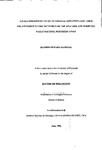A PALAEOMAGNETIC STUDY OF CRUSTAL ROTATIONS AND THEIR RELATIONSHIP TO THE TECTONICS OF THE ATACAMA AND DOMEYKO FAULT SYSTEMS, NORTHERN CHILE
| dc.contributor.author | RANDALL, DARREN EDWARD | |
| dc.contributor.other | School of Geography, Earth and Environmental Sciences | en_US |
| dc.date.accessioned | 2013-09-16T09:15:28Z | |
| dc.date.available | 2013-09-16T09:15:28Z | |
| dc.date.issued | 1996 | |
| dc.identifier | NOT AVAILABLE | en_US |
| dc.identifier.uri | http://hdl.handle.net/10026.1/1728 | |
| dc.description.abstract |
A total of 178 sites have been collected for palaeomagnetic analysis from within two strike-slip fault systems in northern Chile (25.4°S - 26.4°S); the Atacama Fault System in the Coastal Cordillera, and the Domeyko Fault System in the Andean pre-Cordillera. In the Coastal Cordillera, analysis of Middle Jurassic lavas (La Negra Formation) and Middle Jurassic to Early Cretaceous dyke swarms reveal a consistent clockwise rotation of approximately 42°. The remanence from the La Negra Formation passes both fold and reversal tests and is interpreted as a pre-folding remanence. Four of the five dyke swarms have mixed polarity, suggesting that they too carry a primary or very early remanence. The clockwise rotation of the area is interpreted as occurring due to a domino-type mechanism where the blocks are bounded by sinistral faults operating in a crustal scale strike-slip duplex structure. The rotation is the result of sinistral transpression during the middle Cretaceous as a result of the Peruvian Orogeny leading to abandonment of the Jurassic-Early Cretaceous magmatic arc in the Coastal Cordillera and its subsequent eastward migration. The Domeyko Fault System (DFS) comprises the Domeyko Fault Zone (DFZ), and a series of subsidiary faults to the east which define two distinct but slightly overlapping domains: a fold-and-thrust belt in the north and a domain o f sinistral strike-slip faults in the south. Samples were collected from the volcanic rocks of the Sierra Fraga Formation (Middle Jurassic) west of the DFZ, and from the lavas of the Quebrada Vicunita Formation (Late Jurassic) and Cerro Valiente Formation (Palaeocene) from both domains of the DFS. Also sampled in the southern domain, and in a small area between the two domains were sandstones o f the Quebrada Monardes Formation (Early Cretaceous). All of the volcanic units have been remagnetised and no tectonic interpretation is made from them. The sandstones in the southern domain record a clockwise rotation of approximately 24°. This is interpreted as being due to compression across the DFS causing the sinistral strike-slip faults, and the blocks between them to rotate clockwise towards the major tectonic structure, the DFS. The sandstones in the central area between the two domains record an anticlockwise rotation of approximately 28°. This is explained by small-scale rotation of thrust sheets or slip on minor dextral strike-slip faults. The deformation and rotation in the pre-Cordillera occurred in response to the Incaic Orogeny during the Miocene-Oligocene. | en_US |
| dc.description.sponsorship | Servicio Nacional de Geologi'a y Mineria (SERNAGEOMTN), Chile | en_US |
| dc.language.iso | en | en_US |
| dc.publisher | University of Plymouth | en_US |
| dc.title | A PALAEOMAGNETIC STUDY OF CRUSTAL ROTATIONS AND THEIR RELATIONSHIP TO THE TECTONICS OF THE ATACAMA AND DOMEYKO FAULT SYSTEMS, NORTHERN CHILE | en_US |
| dc.type | Thesis | |
| plymouth.version | Full version | en_US |
| dc.identifier.doi | http://dx.doi.org/10.24382/4592 | |
| dc.identifier.doi | http://dx.doi.org/10.24382/4592 |
Files in this item
This item appears in the following Collection(s)
-
01 Research Theses Main Collection
Research Theses Main


